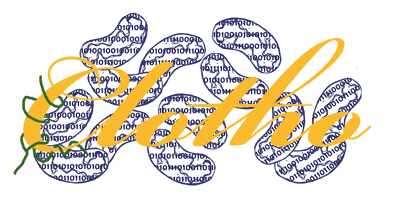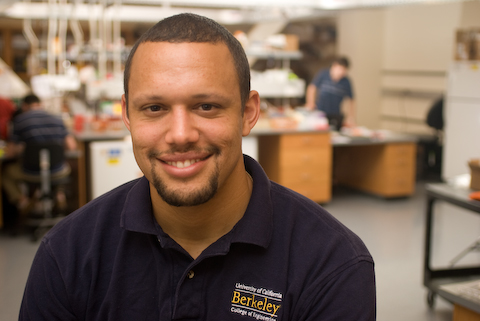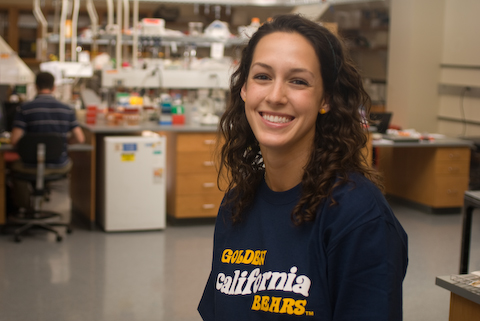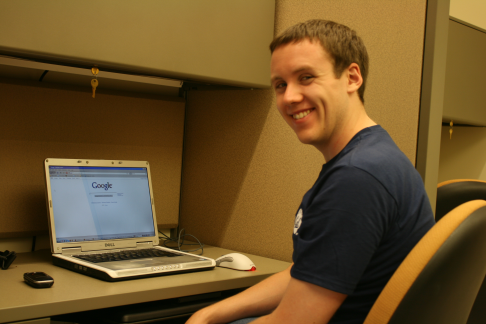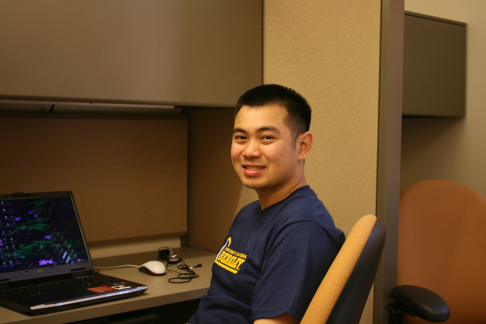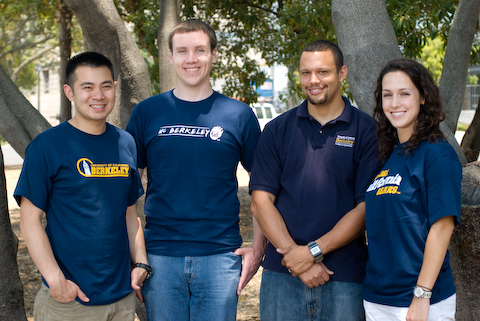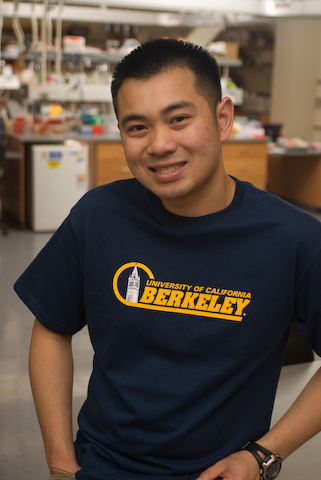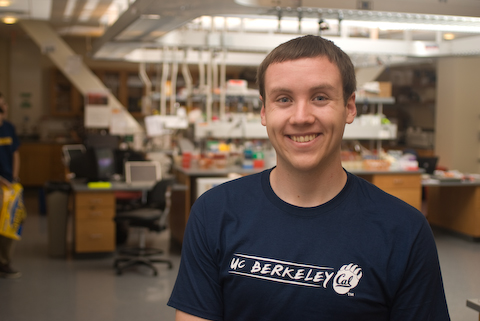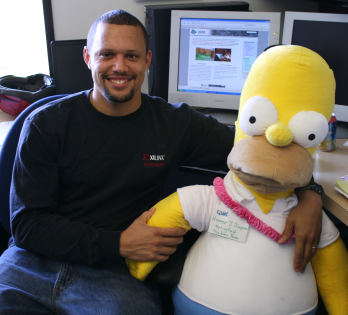Team:UC Berkeley Tools/Team
From 2008.igem.org
Who we are
|
|
|
Team Biographies
Anne Van Devender - Student Member
Anne Van Devender is a 4th year undergraduate at Washington and Lee University (Lexington, VA). She is a Computer Science major with a minor in Women's Studies. After graduation she hopes to attend graduate school for either a master's degree or PhD in Human Computer Interaction.
Her main endeavor outside of academics is the Washington and Lee Women's Soccer team where she is captain and a three-year letter winner. In 2007, she was named to the NSCAA All-America team. When she is not on the field or in the classroom, she enjoys working with kids in the Lexington community including involvement in a literacy campaign and teaching middle school girls the basics of computer science.
This summer she is participating in the Summer Undergraduate Program in Engineering Research at Berkeley (SUPERB) and working with the iGEM 2008 UC Berkeley Computational Team. She is using Java to write an "Algorithm Manager" for the Clotho tool. While she has used Java extensively in her coursework at W&L, the synthetic biology aspect of the project is completely new to her. The last time she took biology was in 9th grade! She hopes this project will not only improve her research skills in computer science, but will also enlighten her to the emerging field of synthetic biology.
Nade Sritanyaratana - Student Member
Nade Sritanyaratana is a 3rd year undergraduate at the University of California, Berkeley. He is majoring in Bioengineering with a concentration in imaging, and hopes to apply for a PhD graduate program in the upcoming year. Beyond imaging, his academic interests include Biomechanics; signals and systems; circuit analysis; systems biology; and linear optimization.
His prior research experience consists of working with [http://bioeng.berkeley.edu/cv.php?facultyid=3022 bioengineering professor Steven Conolly] in the Summer and Fall of 2007. During that summer, he designed a coil helmet with an induced [http://en.wikipedia.org/wiki/Maxwell_coil Maxwell magnetic field]. This magnetic coil could be worn on the head and activated to generate small magnetic waves, soothing the wearer. Nicknamed the “Happy Helmet”, it was designed to non-invasively treat the bipolar-depressed via magnetic stimulation. Once fully developed, the helmet was to cost a hundred-fold less than an [http://en.wikipedia.org/wiki/Functional_magnetic_resonance_imaging fMRI], the current primary treatment to bipolar depression.
This summer Nade is working full-time with the iGEM 2008 Cal Computational Team. This is his first time using Java. Prior to Java, his programming experience included an introductory C++ class in the 9th grade and MATLAB experience for three years in Berkeley. He has had prior experience with computational modeling in general; last year Nade worked with LabVIEW for his introductory class to signals and systems. Last fall he graphically modeled a growing brain tumor with ADINA for his Biomechanics class, and later based his main Biofluid mechanics project on the dynamics of a atherosclerotic artery using a computational model generated by COMSOL.
Matthew Johnson - Student Member
Dr. Douglas Densmore - Instructor
Douglas Densmore received his Bachelors of Science in Engineering (Computer Engineering) from the University of Michigan in April 2001. He received his Masters of Science in Electrical Engineering in May 2004 from the University of California at Berkeley. His masters thesis was entitled, "Platform Based Reconfigurable Architecture Exploration via Boolean Constraints" and demonstrated how Boolean Satisfiability could be used to produce configurations for programmable hardware. He received his PhD in Electrical Engineering from UC Berkeley as well in May 2007. His PhD thesis, entitled "A Design Flow for the Development, Characterization, and Refinement of System Level Architecture Services", explored how electronic system level design methodologies can be abstract and modular while at the same time remaining accurate and efficient.
He is currently a UC Chancellor's post doctoral researcher at UC Berkeley studying under [http://www.eecs.berkeley.edu/~alberto Prof. Alberto Sangiovanni-Vincentelli]. His research area is in the development of System Level Design methodologies for electronic systems. Specifically, architecture modeling and refinement verification. His background and interests are in Computer Architecture, Logic Synthesis, Digital Logic Design and Synthetic Biology.
His industry experience includes four+ summers with Intel Corporation where he was involved in pre-silicon design efforts regarding chipset development, post-silicon validation of the Pentium 4 microprocessor, and chipset software validation. He has also worked as a researcher at Cypress Semiconductor and Xilinx Research Labs. He is currently a member of the [http://www.gigascale.org Gigascale Systems Research Center (GSRC)] and the [http://chess.eecs.berkeley.edu Center for Hybrid and Embedded Software Systems (CHESS)] at UC Berkeley. He has published work regarding a method of successive refinement verification of electronic systems, taxonomies of EDA design tools, and algebraic frameworks for the manipulation of functional design descriptions to expose computational parallelism. In addition he has a US patent pending regarding data characterization of programmable devices (such as field programmable gate arrays).
What we did
This section briefly describes the contributions of each team member.
Matthew LE Johnson
Helped considerably with:
- The About connection/frame
- DNA analysis tools and algorithms (including Translation, G-C content, Melting Temperature, Reverse complementing, etc.)
- The Enzyme Library and associated functionality
- Sequence View connection (with Nade and Doug)
- Compatibility with GenBank, FASTA, and ApE file formats
- Support for degenerate IUPAC codes
- Restriction site search and highlighting
- Forward and reverse Open Reading Frame search and highlighting
- Clotho Preferences for various connections
- All of the Clotho Transfer Handlers
- Intelligent Drag and Drop (DnD) between connections
- Work on the Comp. Team Wiki
- Feedback and advice on the graphic designs (seriously: thank you, Nade!)
- ... and many, MANY hours of debugging!
Anne Van Devender
Anne Van Devender was responsible for:
- The development and design of the algorithm manager
- Clotho algorithm interface and initial implementation
- The conversion of BioBrick assembly algorithms from Perl to Java
- Aid in the development of 2ab assembly algorithms for Clotho
Nade Sritanyaratana
Nade Sritanyaratana, in semi-chronological order, is attributed to the following work:
- The Help connection/frame
- Highlighting
- Features connection
- Co-coordinated Sequence View connection/frame alongside Matt and Doug
- Sequence View Tools (Find/Replace)
- Feature Library Collection connection/frame
- File Choosers
- Search Helper
- .txt file Helper
- Photographing at test sessions
- Debugging post-test sessions
- Parts Manager
- Maintaining the iGEM 2008 Computational Tools Team wiki: layout and painted graphics
- Maintaining the Cal College of Engineering iGEM blog alongside Marlee Tichenor and Madvhi Venkatesh of the wet team
- Clotho iGEM logo and woman
- Clotho iGEM t-shirt
Dr. Douglas Densmore
Doug provided the initial Clotho software infrastructure and served as the main team lead. He helped to keep the team on track and supervised the construction and functionality of Clotho. He is the chief architect of Clotho and in charge of its maintenance, deployment, and promotion.
Dr. Chris Anderson
Prof. Anderson provided specifications for what tools and techniques should be incorporated in Clotho. In addition he also helped to define the general assembly problem for standardized biological parts as well as provide the context in which the tool would be used. He also provided many interesting discussion regarding the Clotho data model and provided the database by which we did the majority of our testing.
Other attribution
Many thanks to Collin Martin for the professional photography shots, and the Comp team shot.
Shout out goes to Cici Chen of the UC Berkeley wetlab for helping design the Clotho title (alpha). Also Brian Zimmer, Bing Xia, and Roger Tu also have contributed to the development of Clotho. Josh Kittleson was instrumental in the development of the mySQL/PoBoL connection and tools. Will Deloache helped with the development of the assembly algorithms for 2ab assembly that is in the tool.
Where we're from
Dr. Douglas Densmore
Doug is from Richland, Michigan which is a small town outside of Kalamazoo. He attended the University of Michigan from 1996-2001 and has been in Berkeley, California since 2001. His family is from the Detroit area. They still live in Michigan.
Nade Sritanyaratana
Nade is a 4th year bioengineering undergraduate at UC Berkeley. He was born in the SF Bay Area, in Hayward, CA, and has lived around the Bay Area his entire life. Both of his parents are Thai. He attended James Logan High School in Union City, CA, where his primary activities included speech and debate, Leo Club, and the swim team. His family still resides in Union City.
Matthew L.E. Johnson
Matt is a SoCal native - born and raised in Bakersfield, CA right up until the move to Berkeley in 2005. He loves his hometown, but realizes that it is an 'acquired taste', especially during the average summer's daily triple-digit heat. Despite the vast differences between his new home and his old (with inverse climates - politically and meteorologically), he has adapted well and has been greatly enjoying his stay in the Bay Area.
 "
"
